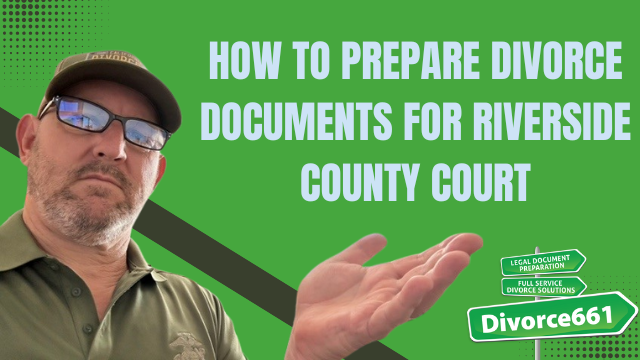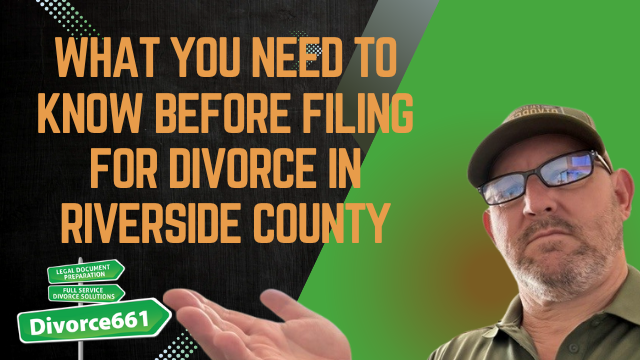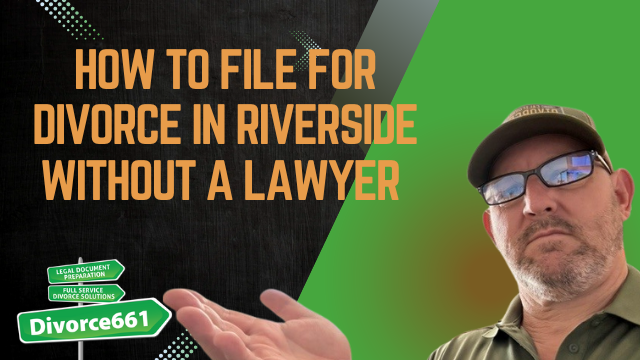How to Prepare Divorce Documents for Riverside County Court
I’m Tim Blankenship with Divorce661. If you’re filing for divorce in Riverside County, California, you already know how high the stakes are: one small paperwork error can stall your case for weeks or months. In this article I’ll walk you through the exact documents you need, the most common mistakes I see, how to serve your spouse correctly, what financial disclosures are mandatory, and a real client example of how correcting paperwork can speed up a stalled divorce.
Why getting your paperwork right matters
Riverside County courts are strict. Even minor mistakes—missing information, incorrect forms, or improperly drafted judgment paperwork—can result in your filing being rejected. That means delays, extra costs, and added stress. The best approach is to prepare complete, accurate documents up front so your case can move forward smoothly.
Incorrect or incomplete judgment paperwork is the most common mistake.
Key documents you must file
At minimum, make sure these are prepared correctly before you submit to the court:
- Petition (the document that starts the case and states the relief you’re seeking).
- Summons (required to notify your spouse that a divorce has been filed).
- UCCJEA (Uniform Child Custody Jurisdiction and Enforcement Act) form when children are involved—this establishes jurisdiction and is mandatory for custody matters.
- Judgment paperwork (proposed judgment or judgment forms) — this is where many rejections occur because these forms must match your settlement terms and be completed precisely.
Proper service of your spouse
How you serve your spouse matters. Improper service can lead to delays or even dismissal. Common options include personal service (a third party hands documents to your spouse) or service by mail with a proof of service. Make sure the method you use complies with California and Riverside County rules and that proof of service forms are completed and filed.
Mandatory financial disclosures
Riverside County requires full financial transparency. Never skip these forms—your filing can’t advance without them:
- Income and Expense Declaration (lists monthly income, expenses, and employment status).
- Schedule of Assets and Debts (all property, bank accounts, retirement, loans, credit cards, etc.).
- Other required disclosures such as tax returns or pay stubs if requested.
These documents are essential for determining support, division of assets, and ensuring the court has the information it needs to issue a judgment.
Common mistakes and how to avoid them
To reduce the risk of rejection, watch for these frequent errors:
- Incomplete or inconsistent judgment paperwork—ensure every number and term matches your settlement documents.
- Missing financial disclosures—don’t file without Income & Expense and Schedule of Assets and Debts completed.
- Incorrect service or missing proof of service—follow service rules and file proof promptly.
- Using the wrong or outdated forms—always use current California and Riverside County forms.
- Filing errors when submitting—double-check e-filing requirements and attachments before submission.
Real client example: how paperwork problems cause delays
Here’s an anonymized real-life scenario: a couple attempted a do-it-yourself divorce and submitted their judgment paperwork twice, only to be rejected both times due to incomplete and inconsistent forms. They spent months waiting with no progress.
We stepped in, corrected and completed the judgment and disclosure documents, filed everything electronically, and the divorce was approved within a few weeks. The difference was attention to detail, correct form completion, and proper e-filing.
How we handle Riverside County divorces at Divorce661
At Divorce661 we prepare, file, and help finalize divorces for amicable couples in California. Our process focuses on accuracy and speed so you avoid the typical delays associated with rejected paperwork.
- We prepare all required forms, including judgment paperwork and financial disclosures.
- We verify that service and proof of service are done correctly.
- We file electronically where available to speed up processing.
- We offer our service 100% remotely for your convenience.
- We work for one flat fee—no hourly attorney billing for straightforward, uncontested divorces.
Checklist: Ready to file in Riverside County?
- Complete the Petition and Summons accurately.
- Fill out and attach the UCCJEA if you have children.
- Prepare and double-check judgment paperwork to ensure consistency.
- Complete Income & Expense Declaration and Schedule of Assets and Debts.
- Serve your spouse correctly and file the Proof of Service.
- Confirm you’re using the current county and state-approved forms.
- Consider electronic filing to speed up processing.
Conclusion and next steps
Filing for divorce in Riverside County doesn’t have to be slow or stressful—but paperwork mistakes will make it so. If you want to avoid rejections and delays, focus on complete and accurate judgment paperwork, mandatory disclosures, and proper service.
If you’d like help preparing and filing your documents, schedule a free consultation with us at Divorce661. We handle the paperwork from start to finish, remotely, for a single flat fee. Visit divorce661.com to learn more and book your consultation.










